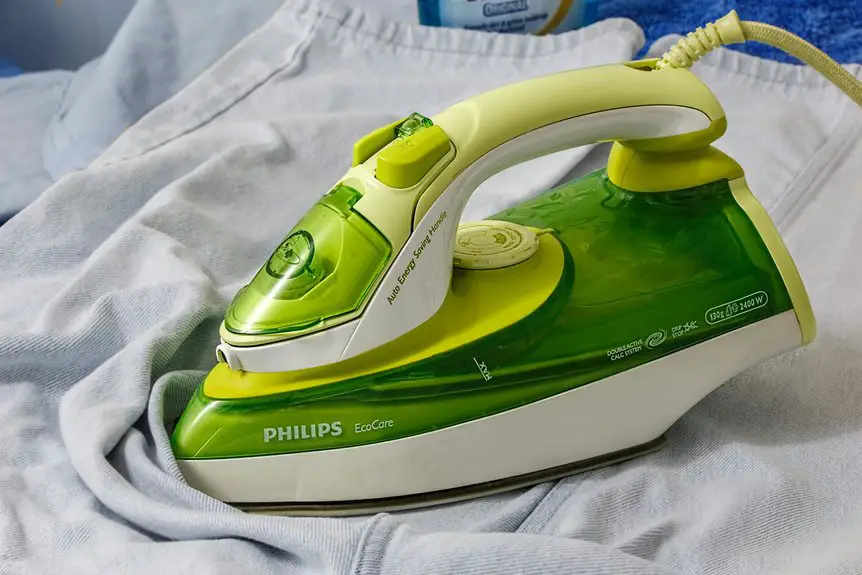If your iron leaves marks or more wrinkles on your clothes, first check the temperature settings and verify they match the fabric type. Always prep your fabric by smoothing it out and lightly dampening stubborn wrinkles. A firm surface helps prevent distortion, while effective steam usage can tackle tough creases. Consider alternative methods like garment steamers or damp cloths. To avoid future issues, learn more about proper techniques and maintenance tips.
Table of Contents
Key Takeaways
- Check and clean the iron’s soleplate to remove residue that can transfer marks to fabrics.
- Ensure the iron is set to the appropriate temperature for the fabric type to prevent scorching.
- Use a firm ironing surface to avoid fabric distortion and achieve smoother results.
- Try steaming techniques, like using a garment steamer or hanging clothes in a steamy bathroom, for wrinkle removal.
- If marks persist, consider alternative solutions like fabric relaxer spray or a damp cloth with a hairdryer.
Understanding the Causes of Iron Marks
Although ironing is meant to smooth out wrinkles, it can sometimes leave unsightly marks on your clothes. These marks often stem from residue on the iron’s soleplate, like melted fabric fibers or starch buildup. If you’re using a dirty iron, you risk transferring these substances onto your garments.
Additionally, overheating certain fabrics can scorch them, leading to brown or shiny spots. Sometimes, using the wrong fabric setting can cause the fibers to burn or become damaged, creating those unwanted marks.
Finally, moisture can also play a role; if your clothes are too wet or you’re using steam improperly, it can create water stains. Understanding these causes helps you prevent future mishaps and keep your clothes looking fresh and clean.
Checking and Adjusting Iron Temperature
When ironing, it’s essential to check the heat settings based on the fabric you’re working with.
Different materials require different temperatures to avoid damage and prevent marks.
Adjusting your iron’s temperature appropriately can save your clothes and guarantee a smooth finish.
Fabric Heat Requirements
Knowing the right temperature for your fabric is essential to prevent damage and achieve the best results while ironing. Each fabric type requires specific heat settings to guarantee they’re ironed effectively without scorching or leaving marks. Here’s a quick reference guide to help you:
| Fabric Type | Recommended Temperature | Iron Setting |
|---|---|---|
| Cotton | 400°F (204°C) | High |
| Linen | 445°F (229°C) | High |
| Polyester | 300°F (149°C) | Medium |
| Silk | 250°F (121°C) | Low |
| Wool | 350°F (177°C) | Medium |
Always double-check your iron’s settings and adjust accordingly. This way, you’ll guarantee your fabrics stay in great shape while looking their best!
Adjusting for Fabric Types
To achieve the best results while ironing, you need to check and adjust your iron’s temperature based on the fabric type you’re working with. Different fabrics require different heat levels; for example, cotton can handle higher temperatures, while delicate fabrics like silk need much lower settings. Always refer to the care label for guidance.
Before you start, test the iron on a small, inconspicuous area to verify it won’t scorch or damage the fabric. If you notice any marks or burns, immediately lower the temperature.
Choosing the Right Fabric for Ironing
When it comes to ironing, choosing the right fabric can make all the difference.
You’ll want to contemplate the fabric’s wrinkle resistance and heat sensitivity levels to avoid unwanted marks.
Understanding which fabrics are best for ironing will help you achieve smooth, crisp results every time.
Fabric Wrinkle Resistance
Choosing the right fabric can make a significant difference in how easily you can iron out wrinkles.
Look for materials with natural wrinkle resistance, such as cotton blends or synthetics like polyester. These fabrics tend to hold their shape better and require less effort to smooth out.
Linen, while elegant, creases easily, so consider it for garments you don’t need to iron often. For everyday wear, wrinkle-resistant cotton is a great choice—it’s comfortable and simplifies your ironing routine.
When selecting fabrics, check for labels that indicate wrinkle resistance, as these will save you time and frustration.
Ultimately, the right fabric choice can keep you looking sharp with minimal ironing hassle.
Heat Sensitivity Levels
Understanding heat sensitivity levels is essential for preventing damage to your fabrics while ironing. Different materials react uniquely to heat, so knowing which fabrics can withstand high temperatures is vital.
For instance, cotton and linen generally handle higher heat well, while synthetic fabrics like polyester and nylon can melt or become damaged at lower temperatures. Always check the care label on your garments to determine the recommended heat settings.
If you’re unsure, start with a lower temperature and gradually increase it. This approach helps you avoid scorching or leaving marks on your clothes.
Best Fabrics for Ironing
Selecting the right fabric for ironing can make your task much easier and more effective. Some fabrics respond beautifully to heat, while others can be a challenge. Cotton is a top choice; it’s durable and holds up well under high temperatures. Linen also irons well, giving a crisp finish. On the other hand, synthetic fabrics like polyester can be trickier, as they may melt or become damaged if the heat is too high.
Here’s a quick comparison to help you choose:
| Fabric Type | Ironing Ease |
|---|---|
| Cotton | Easy |
| Linen | Easy |
| Polyester | Difficult |
Importance of a Firm Ironing Surface
A firm ironing surface is essential for achieving smooth, wrinkle-free results, as it provides the stability needed to press fabrics effectively. Without a sturdy base, you risk creating more wrinkles instead of removing them.
Here’s why a solid ironing surface matters:
A solid ironing surface is crucial for effective pressing, ensuring smooth, wrinkle-free results with less effort.
- Prevents fabric distortion: A stable surface keeps your clothes in place.
- Enhances heat distribution: It allows for even heat transfer, making ironing more efficient.
- Supports various fabrics: Different materials require different pressures; a firm surface accommodates that.
- Reduces snagging: A flat surface minimizes the risk of catching fabric fibers.
- Improves overall results: You’ll achieve a polished look with less effort.
Investing in a quality ironing board can make all the difference in your ironing routine!
Utilizing the Steam Function Effectively
To get the most out of your iron’s steam function, you need to adjust the steam settings based on the fabric type.
Using steam is especially helpful for delicates, as it can remove wrinkles without damaging the material.
Don’t forget to maintain the steam function regularly to guarantee it works effectively every time you iron.
Adjust Steam Settings Properly
While you might be enthusiastic to tackle your ironing, adjusting the steam settings properly can make a significant difference in achieving wrinkle-free clothes without leaving marks.
Here’s how to get it right:
- Choose the right fabric setting: Different fabrics need different steam levels.
- Use the burst of steam feature: This can help tackle stubborn wrinkles.
- Keep the distance: Hold the iron at least an inch away from the fabric to prevent burns.
- Don’t overdo it: Too much steam can saturate the fabric, causing watermarks.
- Test on a small area: Always test the steam on a hidden section to avoid damage.
Use Steam for Delicates
When you’re dealing with delicate fabrics, using steam can be a game-changer for removing wrinkles without causing damage. Instead of direct heat, the gentle moisture relaxes fibers, making it safer for items like silk or lace.
Start by hanging your garment or laying it flat on an ironing board. Hold the iron a few inches away and activate the steam function. This allows the steam to penetrate the fabric without direct contact, minimizing the risk of burns or marks.
For stubborn wrinkles, you can lightly press the fabric with your hand, but be cautious. Always test on a small, inconspicuous area first.
With the right technique, you’ll keep your delicates looking fresh and wrinkle-free!
Maintain Steam Function Regularly
Regularly maintaining your iron’s steam function is essential for effective wrinkle removal and preventing fabric damage. Neglecting this can lead to clogged steam vents and uneven steam distribution.
Here’s how to keep it in top shape:
- Descale Regularly: Use a descaling solution to remove mineral buildup.
- Clean the Steam Vents: Wipe them with a soft cloth to guarantee proper steam flow.
- Use Distilled Water: This reduces mineral deposits and extends your iron’s lifespan.
- Empty the Water Tank: After each use, empty the tank to prevent stagnant water.
- Check for Leaks: Inspect the iron for leaks, which can indicate maintenance issues.
Regular Maintenance of Your Iron
To keep your iron in top shape and prevent unwanted marks, it’s essential to follow a regular maintenance routine.
Start by cleaning the soleplate after every few uses to remove any residue or buildup. Use a soft cloth and a suitable cleaner to wipe it down.
Regularly clean the soleplate with a soft cloth and suitable cleaner to eliminate residue and buildup for optimal performance.
Don’t forget to check the water reservoir; empty it after each use to prevent mineral buildup.
Periodically inspect the cord for frays or damage, as a faulty cord can be dangerous.
If your iron has a steam function, flush it out regularly to keep it working smoothly.
Finally, store your iron upright when not in use to protect the soleplate.
With consistent care, your iron will perform better and last longer.
Prepping Fabrics Before Ironing
Before you start ironing, taking a few moments to prep your fabrics can make all the difference in achieving crisp, wrinkle-free results.
Here are some essential steps to follow:
- Check the care label: Know the fabric type and recommended ironing temperature.
- Sort your fabrics: Group similar materials together to avoid temperature mishaps.
- Dampen the fabric: Lightly spray water or use a steam setting to ease stubborn wrinkles.
- Smooth out the fabric: Lay it flat and remove any large creases by hand before ironing.
- Iron in sections: Work on smaller areas to guarantee every part gets the attention it needs.
Exploring Alternative Wrinkle Removal Methods
While ironing is a tried-and-true method for tackling wrinkles, there are several alternative techniques you can explore that can save time and effort. Consider using a garment steamer, which quickly releases steam to smooth out wrinkles without direct contact. Another option is to hang your clothes in the bathroom while you take a hot shower; the steam can help relax the fabric. You might also try using a damp cloth and a hairdryer for a quick fix.
| Method | Time Required | Effectiveness |
|---|---|---|
| Garment Steamer | 5 minutes | High |
| Shower Steam | 10 minutes | Moderate |
| Damp Cloth & Dryer | 3 minutes | Moderate |
| Spray & Smooth | 5 minutes | High |
| Fabric Relaxer Spray | 2 minutes | Low |
Advanced Technologies in Ironing
As you seek to simplify your ironing routine, advanced technologies are transforming how we tackle wrinkles.
These innovations make the process quicker and more effective, allowing you to enjoy wrinkle-free clothes without the hassle.
- Steam Control Systems: Adjust steam output for different fabrics.
- Smart Sensors: Detect fabric types and automatically set temperature.
- Cordless Designs: Enhance mobility and reduce tangling.
- Self-Cleaning Features: Maintain your iron’s performance with minimal effort.
- Ultrasonic Technology: Use sound waves to remove wrinkles without direct contact.
With these advancements, you can achieve professional results at home, freeing up your time for what really matters.
Embrace these smart tools and elevate your ironing experience!
Tips for Preventing Future Ironing Issues
To keep your clothes looking fresh and free from marks, it’s essential to adopt some proactive ironing habits.
First, always check the iron’s soleplate for dirt or residue before use; a clean surface prevents unwanted marks.
Next, use the right heat setting for each fabric type—too high can scorch, while too low can leave wrinkles.
Additionally, consider using a pressing cloth, especially for delicate fabrics, to protect them from direct contact with the iron.
Iron clothes when they’re slightly damp, as this helps smooth out wrinkles more effectively.
Finally, store your iron upright and allow it to cool completely before putting it away to avoid damaging its surface.
With these steps, you’ll minimize future ironing issues.
Frequently Asked Questions
Can I Use Vinegar to Clean My Iron’s Soleplate?
Yes, you can use vinegar to clean your iron’s soleplate. Mix equal parts of vinegar and water, apply it to a cloth, and gently wipe the soleplate. This helps remove residue and keeps it functioning well.
How Often Should I Replace My Ironing Board Cover?
You should replace your ironing board cover every six months to a year, depending on use. If you notice stains, burns, or wear, it’s time for a new cover to guarantee better pressing results.
Is It Safe to Iron Clothes While They Are Wet?
Imagine rushing to a meeting, your shirt damp and wrinkled. Ironing wet clothes isn’t safe; it can cause fabric damage or leave water marks. It’s better to let them dry slightly before pressing for best results.
What Are the Best Fabrics for Wrinkle Resistance?
If you’re looking for wrinkle-resistant fabrics, opt for polyester, nylon, or spandex blends. These materials repel creases effectively, keeping your clothes looking fresh and crisp without much effort on your part. You’ll love the results!
Can Steam Damage Certain Types of Clothing?
Steam can wreak havoc on delicate fabrics, practically turning them to mush. You should avoid using steam on silk, rayon, or any fabric labeled as dry clean only, as it can cause irreversible damage.
- How to Get Wrinkles Out of Nylon or Spandex? - June 10, 2025
- Does Rolling Clothes Instead of Folding Prevent Wrinkles? - June 10, 2025
- How to Get Creases Out of New Clothes? - June 9, 2025







